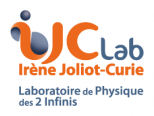Antiproton decelerator Clustering Conversion electrons Dark matter GBAR Gravity History of science Light nuclei MONSTER New Jedi NFS Nuclear matter PARIS Podcast Pygmy resonance SIRIUS Superheavy elements
- SIRIUS sees its first beam at GANILSuper-heavy elements do not exist in nature and can only be synthesized at accelerator facilities in minuscule amounts amidst a huge background of other nuclear reaction products. For a successful experiment, two conditions must be satisfied: to be able to select the events corresponding to the production of the nuclei of interest and to be… Read more: SIRIUS sees its first beam at GANIL
- Experimental studies of clustering in light nucleiThe phenomenon of cluster formation is a widespread occurrence in different physical environments, being characterized by the partial or total aggregation of the elementary constituents in complex structures which break the environment’s overall homogeneity. In such systems, the cluster formation is accompanied by a gain of stability (larger binding) with respect to the homogeneous phase.… Read more: Experimental studies of clustering in light nuclei
- The astonishing superheavy elementsThe infinitely large and the infinitely small are the natural limits of human perception. While situated at opposite extremes in terms of size, the two concepts are united by the fact that they are the frontiers of scientific inquiry and by the aspiration that one day the phenomena governing the two realms will be described… Read more: The astonishing superheavy elements
- The nuclear pygmy resonance studied at SPIRAL2-NFSIn the framework of an international collaboration led by Irfu/DPhN and IJCLab, an experiment aiming to study the pygmy dipole resonance in the 140Ce nucleus (composed of 58 protons and 82 neutrons) has just been performed at GANIL-SPIRAL2, using the NFS (Neutron For Science) installation. The pygmy dipole resonance (PDR) is a vibration mode of neutron-rich… Read more: The nuclear pygmy resonance studied at SPIRAL2-NFS
- Speaking of the atom on the radioThe question is “quite simple”: how quantum physics will complicate the approach to the atom and particularly its relation to the understanding of the electron? To answer this question and many others of Antoine Beauchamp, Marlène Assié from IJCLab has joined Charlotte Bigg from Centre Alexandre-Koyré as guests on the radio program “Eurêka” of France Culture.… Read more: Speaking of the atom on the radio
- Commissioning of the COeCO setupThe new experimental setup COeCO designed for the study of β-delayed conversion electrons emitted by neutron-rich nuclei produced by ALTO (Orsay), has recently been built, assembled and tested. The system features two magnetic coils (in red in the left picture above and grey in the right one) in order to transport electrons from the collection… Read more: Commissioning of the COeCO setup
- GBAR on France CultureHow antimatter interacts with gravity is one of the key questions in physics which are simple enough to ask, but incredibly difficult to answer, especially if the answer is supposed to be rooted in experimental proof. In the case of this particular question, the difficulty is at least two-fold: firstly, due to the infinitesimal strength… Read more: GBAR on France Culture
- Dark Boson: New JEDI at Andromède for a first experimentThe hall of the Andromède accelerator is in full activity at the end of 2021. Three experiments are being set up there, STELLA, NanoCR and New JEDI. New JEDI is the acronym for New Judicious Experiment for Dark sectors Investigations. This is a scientific project supported by an international collaboration bringing together many laboratories: IJCLab… Read more: Dark Boson: New JEDI at Andromède for a first experiment






